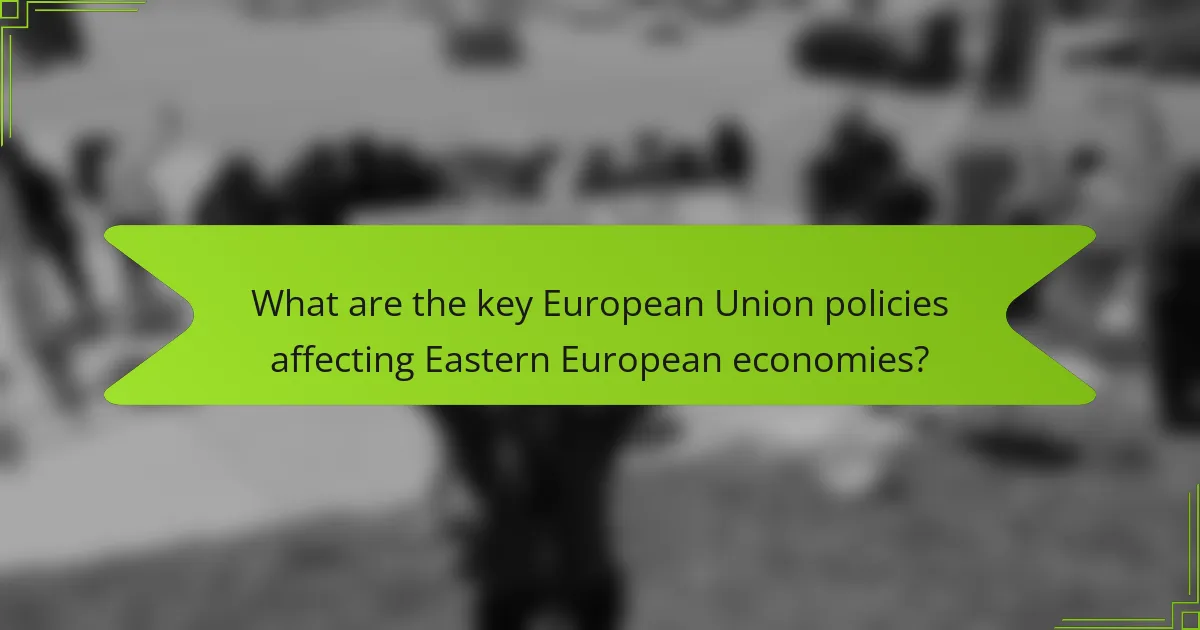European Union (EU) policies play a crucial role in shaping the economies of Eastern European countries. Key policies include the Cohesion Fund, which allocates €63 billion for infrastructure and development to reduce economic disparities; the Common Agricultural Policy, providing approximately €386 billion in subsidies to support sustainable agriculture; and the Single Market, which facilitates the free movement of goods, services, and labor to enhance trade and investment. Since the early 1990s, EU strategies have evolved from stabilization efforts post-Soviet Union to integration initiatives, including the Eastern Partnership launched in 2009. These policies aim to foster economic growth, attract foreign investment, and promote modernization in Eastern European economies, while also posing challenges related to compliance and adaptation to EU regulations.

What are the key European Union policies affecting Eastern European economies?
Key European Union policies affecting Eastern European economies include the Cohesion Fund, Common Agricultural Policy, and the Single Market. The Cohesion Fund aims to reduce economic disparities by providing financial support for infrastructure and development projects. This fund allocates approximately €63 billion for 2021-2027 to improve economic stability in less developed regions. The Common Agricultural Policy supports farmers through subsidies and promotes sustainable agriculture practices. It allocates around €386 billion for the same period, benefiting rural economies in Eastern Europe. The Single Market enables free movement of goods, services, and labor, fostering trade and investment. This policy enhances competitiveness and economic growth in Eastern European countries.
How do trade agreements influence Eastern European economies?
Trade agreements significantly influence Eastern European economies by enhancing trade flows and investment. They reduce tariffs and trade barriers, making exports more competitive. For example, the EU’s Association Agreements with Eastern European countries facilitate access to the EU single market. This access has led to increased foreign direct investment, boosting local industries. According to a report by the European Commission, trade between the EU and Eastern Europe grew by 30% after these agreements. Furthermore, these agreements promote regulatory alignment, improving business environments. Enhanced trade relations also lead to job creation and economic growth in the region. Overall, trade agreements are pivotal in shaping the economic landscape of Eastern Europe.
What specific trade agreements exist between the EU and Eastern Europe?
The European Union has established several trade agreements with Eastern European countries. The most notable agreements include the Association Agreements with countries such as Ukraine, Moldova, and Georgia. These agreements aim to enhance political and economic ties between the EU and these nations.
Additionally, the Deep and Comprehensive Free Trade Areas (DCFTAs) are part of these agreements. The DCFTAs allow for reduced tariffs and improved market access. This facilitates trade in goods and services.
Moreover, the EU has implemented a trade agreement with Armenia and Azerbaijan as well. These agreements support economic reforms and align the countries with EU standards.
Overall, these trade agreements significantly influence Eastern European economies by promoting trade and investment. They also encourage regulatory alignment with EU policies.
How do these agreements impact local industries in Eastern European countries?
These agreements significantly impact local industries in Eastern European countries by enhancing trade opportunities. They facilitate access to larger markets within the European Union. This access often leads to increased competition among local businesses. As a result, industries may innovate to maintain their market positions. Additionally, these agreements typically include provisions for investment, attracting foreign capital to local industries. For instance, the EU’s support for infrastructure projects boosts sectors like construction and logistics. Furthermore, compliance with EU standards can improve product quality, benefiting local consumers. Overall, these agreements foster economic growth and modernization in Eastern European industries.
What role do financial aid and funding play in these economies?
Financial aid and funding are crucial for the economies of Eastern European countries. They provide essential resources for infrastructure development and social programs. This financial support helps stimulate economic growth and improve living standards. For instance, the European Union allocated over €100 billion to Eastern Europe from 2007 to 2013. This funding facilitated projects in transportation, energy, and education. Additionally, financial aid enhances regional stability and promotes democratic governance. It also encourages investment from both domestic and foreign sources. Such support is vital for countries transitioning from planned to market economies.
What types of financial assistance does the EU provide to Eastern Europe?
The EU provides several types of financial assistance to Eastern Europe. These include grants, loans, and technical assistance. The European Structural and Investment Funds support regional development projects. The Instrument for Pre-Accession Assistance offers funding for countries preparing for EU membership. The EU also provides budget support to help stabilize economies. Additionally, the European Neighborhood Instrument funds cross-border cooperation projects. These financial aids aim to promote economic growth and integration within the EU framework.
How effective is EU funding in promoting economic growth in the region?
EU funding is highly effective in promoting economic growth in the region. It provides financial support for infrastructure projects, business development, and social initiatives. For instance, between 2014 and 2020, the EU allocated approximately €350 billion to Eastern European countries. This funding has led to significant improvements in transportation networks and energy efficiency. Studies show that EU funding has increased GDP growth rates by an average of 1.5% in recipient countries. Additionally, it has created thousands of jobs and reduced regional disparities. The European Commission reports that EU investments have strengthened economic resilience in these economies. Overall, EU funding plays a crucial role in driving sustainable growth in the region.

How have EU policies evolved over time in relation to Eastern Europe?
EU policies towards Eastern Europe have evolved significantly since the early 1990s. Initially, the focus was on stabilizing the region post-Soviet Union collapse. The EU introduced the PHARE program in 1989 to provide financial aid and technical assistance. In the late 1990s, the EU began incorporating Eastern European countries through the Stabilization and Association Process. This aimed to prepare these nations for future membership.
By 2004, several Eastern European countries joined the EU, marking a major policy shift. The EU implemented the Common Agricultural Policy and regional development funds to support economic integration. In response to geopolitical tensions, particularly with Russia, the EU has also emphasized energy security and diversification strategies in recent years.
The Eastern Partnership, launched in 2009, further solidified EU relations with Eastern European countries. This initiative aimed to enhance political association and economic integration. Overall, EU policies have transitioned from aid and stabilization to integration and partnership, reflecting the changing political landscape in Eastern Europe.
What historical context is important for understanding these policies?
The historical context important for understanding these policies includes the fall of the Iron Curtain in 1989. This event marked the end of communist regimes in Eastern Europe. Subsequently, many countries sought integration with Western Europe. The expansion of the European Union in 2004 included several Eastern European nations. This enlargement aimed to promote stability and economic growth in the region. The policies implemented were influenced by the desire for economic modernization. Additionally, historical ties and past conflicts shaped these nations’ approaches to EU integration. Economic disparities also played a significant role in policy formulation. These factors collectively provide a comprehensive backdrop for understanding the policies affecting Eastern European economies.
How did the accession of Eastern European countries to the EU change policy dynamics?
The accession of Eastern European countries to the EU significantly altered policy dynamics within the region. These countries adopted EU regulations and standards, leading to harmonization of laws. This shift increased political stability and economic integration. The EU’s influence also encouraged reforms in governance and market structures. Eastern European nations gained access to EU funding, which supported infrastructure development. The accession strengthened regional cooperation among member states. Additionally, it enhanced the EU’s geopolitical presence in Eastern Europe. These changes collectively reshaped policy frameworks and economic strategies in the region.
What key milestones have shaped current EU policies toward Eastern Europe?
Key milestones that have shaped current EU policies toward Eastern Europe include the 2004 EU enlargement, which integrated eight Eastern European countries. This expansion aimed to promote stability and economic growth in the region. The 2010 Eastern Partnership initiative further strengthened ties between the EU and Eastern European nations. The 2014 Ukraine crisis prompted the EU to reassess its policies, leading to increased support for Eastern European countries. Additionally, the EU’s focus on energy security has influenced its approach to Eastern Europe. These milestones collectively reflect the EU’s commitment to fostering integration and stability in the region.
How do current EU policies address economic disparities in Eastern Europe?
Current EU policies address economic disparities in Eastern Europe through funding, investment, and regulatory frameworks. The European Regional Development Fund allocates resources to enhance infrastructure and promote regional development. Cohesion Policy aims to reduce economic inequalities among member states by supporting less developed regions. The EU also encourages private investments through initiatives like the InvestEU program. Furthermore, the EU sets standards that promote fair competition and economic growth. These policies have led to increased GDP growth in Eastern European countries. For example, Poland experienced a GDP growth rate of 4.5% in 2021, partly due to EU funding. Overall, these measures are designed to foster economic convergence within the EU.
What measures are in place to support underdeveloped regions within Eastern European countries?
The European Union implements various measures to support underdeveloped regions within Eastern European countries. These measures include financial assistance through structural funds and investment programs. The European Regional Development Fund allocates resources for infrastructure development. Cohesion Fund investments target transport and environmental projects. The EU also promotes initiatives for job creation and skills training in these regions. Additionally, the EU supports cross-border cooperation projects to enhance regional collaboration. The European Commission regularly monitors the effectiveness of these measures. Reports indicate that EU funding has significantly improved economic conditions in several underdeveloped areas.
How does the EU monitor and evaluate the effectiveness of its policies in Eastern Europe?
The EU monitors and evaluates the effectiveness of its policies in Eastern Europe through various mechanisms. These include regular assessments, reports, and feedback from member states. The European Commission conducts evaluations based on specific indicators related to policy objectives. These indicators assess economic growth, social development, and governance improvements. The EU also engages in stakeholder consultations to gather insights from local communities. Additionally, the EU uses data from Eurostat and other statistical agencies to analyze trends and impacts. This systematic approach ensures that policies are adjusted based on their effectiveness and relevance. The EU’s commitment to transparency enhances accountability in its monitoring processes.

What are the potential future implications of EU policies on Eastern European economies?
EU policies may significantly impact Eastern European economies by enhancing economic integration and development. These policies can lead to increased foreign investment and job creation. Additionally, EU regulations may promote modernization of infrastructure and industries. Trade agreements can improve market access for Eastern European goods. However, stricter compliance requirements may challenge local businesses. The EU’s climate policies could drive a transition to greener technologies. Overall, these implications can foster both growth and adaptation in Eastern European economies.
How might upcoming EU reforms impact Eastern European economies?
Upcoming EU reforms may significantly enhance Eastern European economies. These reforms often focus on structural funds, investment in infrastructure, and regulatory alignment. Increased access to EU funds can stimulate local economies and create jobs. For instance, the EU allocated approximately €23 billion for Eastern European countries in the 2021-2027 budget period. Improved infrastructure can lead to better connectivity and trade opportunities. Regulatory alignment with EU standards can boost foreign investment. Enhanced investment can lead to technological advancements and productivity growth. Overall, these reforms aim to foster economic convergence within the EU.
What areas of reform are currently being discussed within the EU?
Current areas of reform being discussed within the EU include economic governance, migration policy, and climate action. Economic governance reforms focus on enhancing fiscal stability and coordination among member states. Migration policy discussions aim to create a more cohesive approach to asylum and border management. Climate action reforms are centered on achieving the EU’s Green Deal objectives, reducing greenhouse gas emissions by at least 55% by 2030. These reforms are essential for addressing challenges faced by Eastern European economies within the broader EU framework.
How could these reforms affect trade and investment in Eastern Europe?
These reforms could enhance trade and investment in Eastern Europe by improving regulatory frameworks. Streamlined regulations attract foreign direct investment, fostering economic growth. Enhanced infrastructure leads to better connectivity, facilitating trade. Increased transparency builds investor confidence, encouraging capital inflows. For example, the European Union’s support for infrastructure projects has historically boosted trade volumes. According to the European Commission, investment in infrastructure can yield a 10-20% increase in trade efficiency. Overall, these reforms create a more favorable business environment, stimulating economic activity in the region.
What challenges do Eastern European economies face in adapting to EU policies?
Eastern European economies face several challenges in adapting to EU policies. One major challenge is the need for structural reforms. Many Eastern European countries have outdated economic systems that require significant modernization. This modernization often necessitates substantial investment, which can strain limited financial resources.
Another challenge is regulatory compliance. Eastern European nations must align their laws and regulations with EU standards. This process can be complex and time-consuming. Additionally, there is often resistance from local industries accustomed to different regulations.
Economic disparities also pose a challenge. The wealth gap between Eastern and Western EU countries can hinder effective policy implementation. Eastern economies may struggle to compete with more developed nations, leading to unequal benefits from EU membership.
Furthermore, political instability can impact the adaptation process. Frequent changes in government can disrupt long-term policy planning. This instability may also lead to inconsistent approaches to EU integration.
Lastly, public sentiment towards EU policies can be mixed. Some citizens may view EU regulations as encroachments on national sovereignty. This sentiment can complicate the political will needed to implement necessary changes.
How can Eastern European countries better align with EU standards and regulations?
Eastern European countries can better align with EU standards and regulations by implementing comprehensive reforms. These reforms should focus on legal frameworks, governance, and economic policies. Strengthening institutions will enhance compliance with EU laws. Training programs for public officials can improve understanding of EU regulations. Additionally, adopting EU best practices in areas like environmental protection and consumer rights is essential. Financial support from the EU can facilitate these changes. Regular assessments and feedback from EU bodies can ensure ongoing alignment. Historical data shows that countries that actively engage with EU mechanisms experience faster integration. For example, Poland’s reforms in the early 2000s significantly improved its EU alignment.
What strategies can Eastern European economies implement to maximize benefits from EU policies?
Eastern European economies can implement several strategies to maximize benefits from EU policies. First, they should enhance their administrative capacity to effectively manage EU funds. This includes training personnel and streamlining processes for fund allocation. Second, fostering public-private partnerships can drive innovation and economic growth. Collaboration between government and businesses can lead to better project outcomes. Third, Eastern European countries should focus on aligning their national policies with EU standards. This alignment can improve access to markets and funding opportunities. Fourth, investing in infrastructure is crucial. Improved infrastructure can facilitate trade and attract foreign investment. Finally, promoting education and skills development can enhance workforce competitiveness. A skilled workforce is vital for leveraging EU investments. These strategies collectively position Eastern European economies to fully utilize the advantages provided by EU policies.
What best practices can Eastern European nations adopt to enhance economic growth under EU influence?
Eastern European nations can enhance economic growth under EU influence by adopting best practices such as improving governance and strengthening institutions. Effective governance ensures transparency and accountability, which attracts foreign investment. Strengthening institutions helps in implementing EU regulations efficiently.
Additionally, investing in infrastructure is crucial. Improved transportation and communication networks facilitate trade and enhance connectivity. Fostering innovation and supporting small and medium-sized enterprises (SMEs) can drive economic diversification.
Moreover, aligning educational systems with labor market needs prepares a skilled workforce. This alignment is essential for meeting the demands of a modern economy.
Finally, engaging in regional cooperation can enhance trade opportunities. Collaboration among neighboring countries can lead to shared resources and collective growth.
These practices have been shown to yield positive outcomes in various EU member states, reinforcing their validity.
The main entity of the article is the influence of European Union policies on Eastern European economies. The article examines key EU policies such as the Cohesion Fund, Common Agricultural Policy, and Single Market, highlighting their roles in reducing economic disparities, supporting agriculture, and fostering trade. It also discusses the impact of trade agreements, financial aid, and funding on local industries and economic growth, while addressing the historical context and evolution of EU policies in the region. Additionally, the article outlines current challenges faced by Eastern European economies in aligning with EU standards and suggests strategies for maximizing the benefits of EU integration.